Physical Address
304 North Cardinal St.
Dorchester Center, MA 02124
Physical Address
304 North Cardinal St.
Dorchester Center, MA 02124
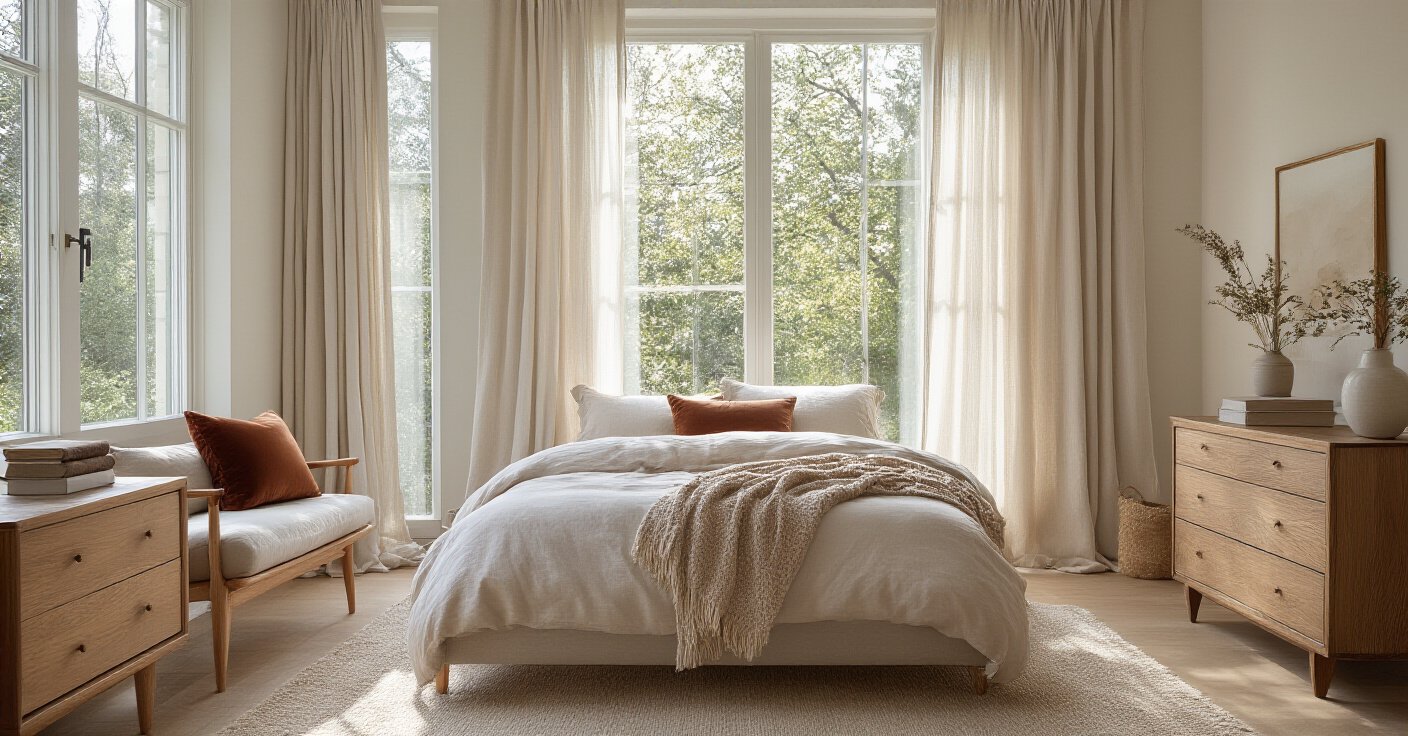
Tune your sanctuary with 21 expert ideas for musicians and creatives. Learn to balance acoustics, lighting, and design for a master bedroom that truly restores.
Everyone thinks a serene bedroom is a quiet one. But here’s what they get wrong: I’ve stood in acoustically “dead” rooms that were so silent, they felt clinical and agitating. Your own heartbeat becomes a distraction. On the other hand, I’ve designed spaces with a soft, low-level ambient hum from a perfectly calibrated air system that felt like the most peaceful place on earth. The goal isn’t just silence; it’s the right kind of sound.
It’s the same with design. A bedroom isn’t a magazine page; it’s an instrument you live inside. It needs to be tuned. The way light hits a surface, the way a rug absorbs the sharp echo of your footsteps, the way your closet door closes with a satisfying thud instead of a cheap click—these details compose the harmony of your personal space. For musicians, audiophiles, and creative people, this isn’t just about sleep. It’s about having a sanctuary where your mind can reset, unclutter, and prepare for the next creation. So let’s talk about how to tune your room, from the foundation up.
Before you pick a single paint chip, you have to get the structure right. Think of this as composing the core melody and rhythm of your room. These are the foundational chords that will support everything else, ensuring your space is not just beautiful, but functional and resonant.
You have to know the key you’re playing in before you can improvise a solo. Defining your “style sanctuary” is about figuring out your room’s key signature. It’s not about picking “boho” or “industrial” from a list; it’s about identifying the textures, colors, and feelings that make your nervous system calm down. For a musician, this is visceral. Do you need the warm, woody resonance of a cello, with dark woods and rich velvets? Or the crisp, airy space of a flute, with light linens and open sightlines?
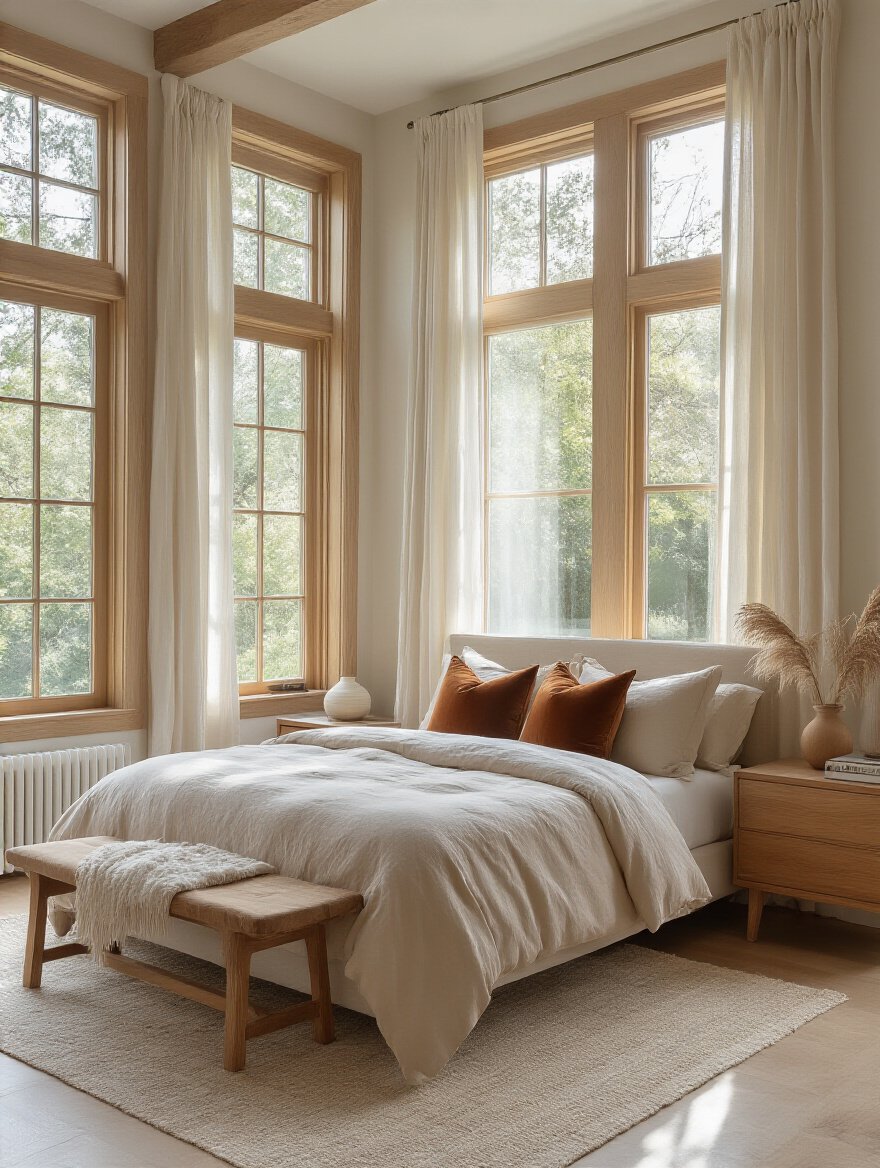
Start by making a playlist, but with images. Go to Pinterest, tear pages out of magazines, whatever. Don’t think, just react. Then, look at the patterns. Are you drawn to curved lines or sharp angles? Saturated colors or muted tones? This isn’t just about looks; it’s about finding the visual frequency that helps your mind unwind. I had a jazz pianist client who realized all his inspiration images featured deep blues and brass, like a smoky club at 2 a.m. That became our North Star for everything.
With a clear style in mind, you can begin to place the instruments in the orchestra—the furniture—for the best possible flow and feel.
The biggest mistake people make is treating their bedroom like a storage unit for a bed. The layout isn’t just about where furniture fits; it’s about choreographing your movement. Think about your path from the door to the bed, from the bed to the closet, from the closet to the window. It should feel like a fluid, graceful musical phrase, not a jarring, staccato series of side-steps around a dresser that’s too big.

Your bed is the conductor’s podium—the focal point. The best spot is usually against a solid wall, giving you a commanding view of the room and a sense of security. Avoid placing it directly under a window if you’re sensitive to light and temperature changes, or directly in line with the door, which can feel exposed. Use painter’s tape on the floor to mock up furniture placement. Walk the paths. Does it feel natural? Can you carry a guitar case through without knocking a lamp over? Don’t move a thing until the tape-dance feels right.
Once you’ve choreographed the basic movements, it’s time to draft the full score: a functional floor plan that accounts for every detail.
A floor plan is more than a sketch; it’s your room’s sheet music. It marks where the crescendos and decrescendos happen in your daily life. Where do you need quiet space for reading a score or meditating? Where do you need brighter, more energetic space for getting ready? These are your “zones.” You can have a sleep zone, a dressing zone, and a relaxation zone, all within the same four walls.

The trick is to define these zones with furniture, rugs, and lighting. A small rug and a comfortable chair in a corner instantly create a “reading nook.” A well-lit mirror and a valet stand create a “dressing station.” Think about adjacencies. It’s a pain to walk across the entire room from your closet to your dresser every morning. Put things that work together, together. And for God’s sake, measure everything. Then measure it again. An inch can be the difference between a drawer that opens fully and one that perpetually hits the bed frame.
As your floor plan solidifies, you’ll inevitably notice the biggest challenge in any composition: managing the clutter.
Clutter is visual noise. It’s sonic chaos for your brain. It pulls focus and prevents true rest. The solution isn’t just buying more bins; it’s about designing storage that feels like it’s part of the room’s architecture. The best storage is the kind you don’t notice. This is where Multi-functional furniture becomes your best friend. A bed with built-in drawers underneath. An ottoman at the foot of the bed that holds extra blankets. A headboard with integrated shelving.

Think vertically. Our eyes are drawn to empty floor space, so the more you can lift off the ground, the bigger and calmer the room will feel. Floating nightstands are fantastic for this. Wall-mounted shelves. Anything that leverages the wall instead of the floor. Before you buy a single thing, though, do a ruthless purge. I tell my clients to use Marie Kondo’s method because it works. You can’t organize clutter. You can only get rid of it.
Now that you know what you’re keeping, it’s time to face the music and figure out what this masterpiece will cost.
Look, we all want the Stradivarius, but sometimes a well-made modern violin gets the job done beautifully. Your budget isn’t a restriction; it’s a creative framework. It forces you to make smart, intentional choices about where to spend your money. I always tell my clients to divide their budget into two categories: “feel” and “flash.”

The “feel” category is non-negotiable. This is where you invest. A high-quality mattress that supports deep sleep. A solid-core door that blocks out noise. Excellent, dimmable lighting. Things that directly impact your sensory experience of the room. “Flash” is the aesthetic stuff—the expensive wallpaper, the designer lamp, the fancy rug. You can find incredible “flash” on a budget if you’ve invested properly in the “feel.” A great-looking room that you can’t sleep in is a failure. Always, always prioritize the things that will make you feel rested and restored. And add 15% to your total budget for a contingency fund. Always. You will need it.
With your budget as your guide, you’re ready for the most creative step in the planning phase: building your visual harmony.
Your mood board is your demo track. It’s where you test out all your ideas to see if they work together before you commit to the final recording. This is the most crucial step for avoiding that “I-bought-a-bunch-of-stuff-I-love-and-now-my-room-looks-like-a-mess” feeling. A mood board ensures every element is playing in the same key and in the same style.
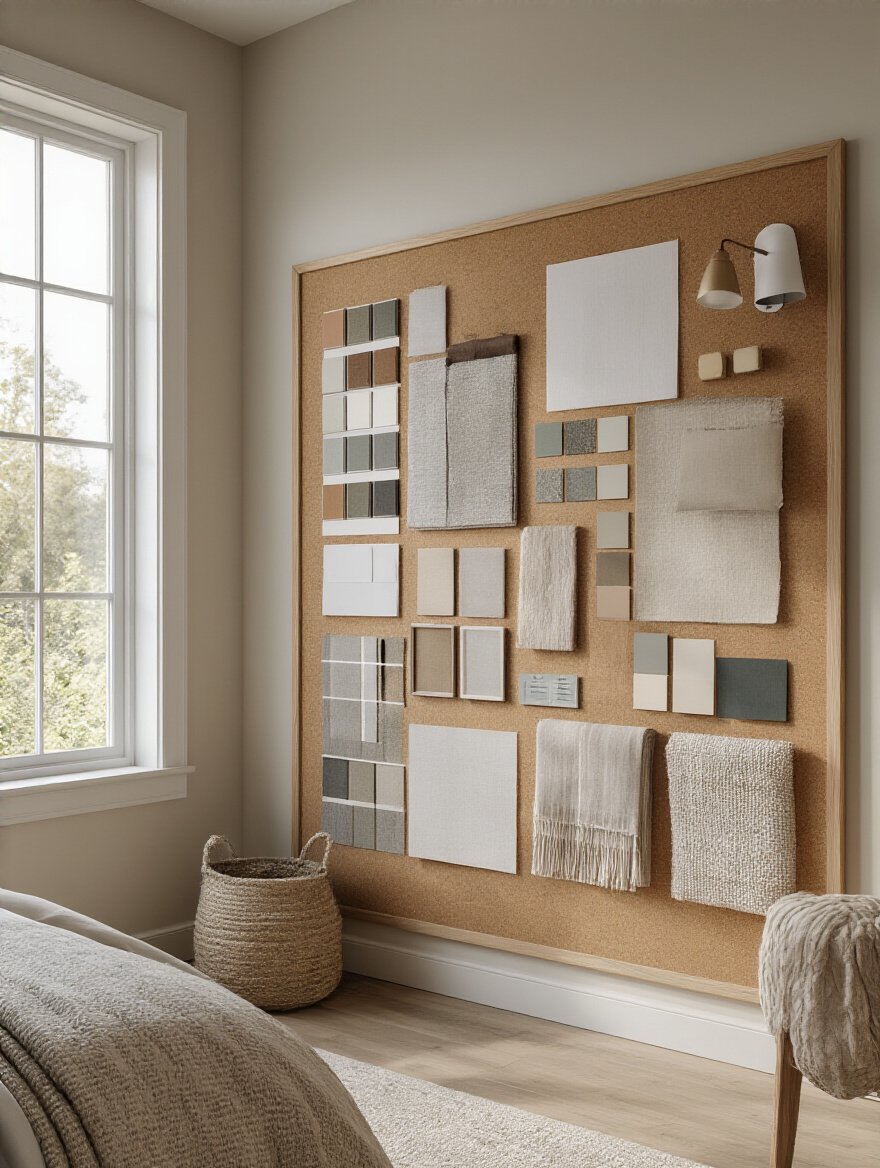
I insist my clients create physical mood boards. Digital is great for gathering, but you can’t feel a pixel. Get actual paint chips, fabric swatches, wood samples, and metal finishes. Pin them all to a corkboard. How does that velvet swatch look next to the brass lamp finish under your chosen paint color? Does the rough linen clash with the smooth silk? You can see and feel the harmony—or the dissonance—immediately. It’s the one step that saves more money and regret than any other.
With a solid foundation in place, you can move on to the really fun part: layering in the aesthetics that transform a room into an atmosphere.
This is where art meets science. We’re now adding the overdubs, the reverb, the textures that give the room its soul. These choices directly affect your senses and are what ultimately create a space that feels like a sigh of relief.
Color isn’t just visual; it’s psychological. And for musicians, it’s often tied to sound (hello, synesthesia). Your bedroom’s color palette sets the emotional tone. While studies say blues and greens are calming—and they are—the most tranquil color for you is the one that personally makes you feel grounded. For some, it might be a dark, enveloping charcoal that feels like a warm blanket. For others, a light, airy greige that feels like clean, open space for the mind.
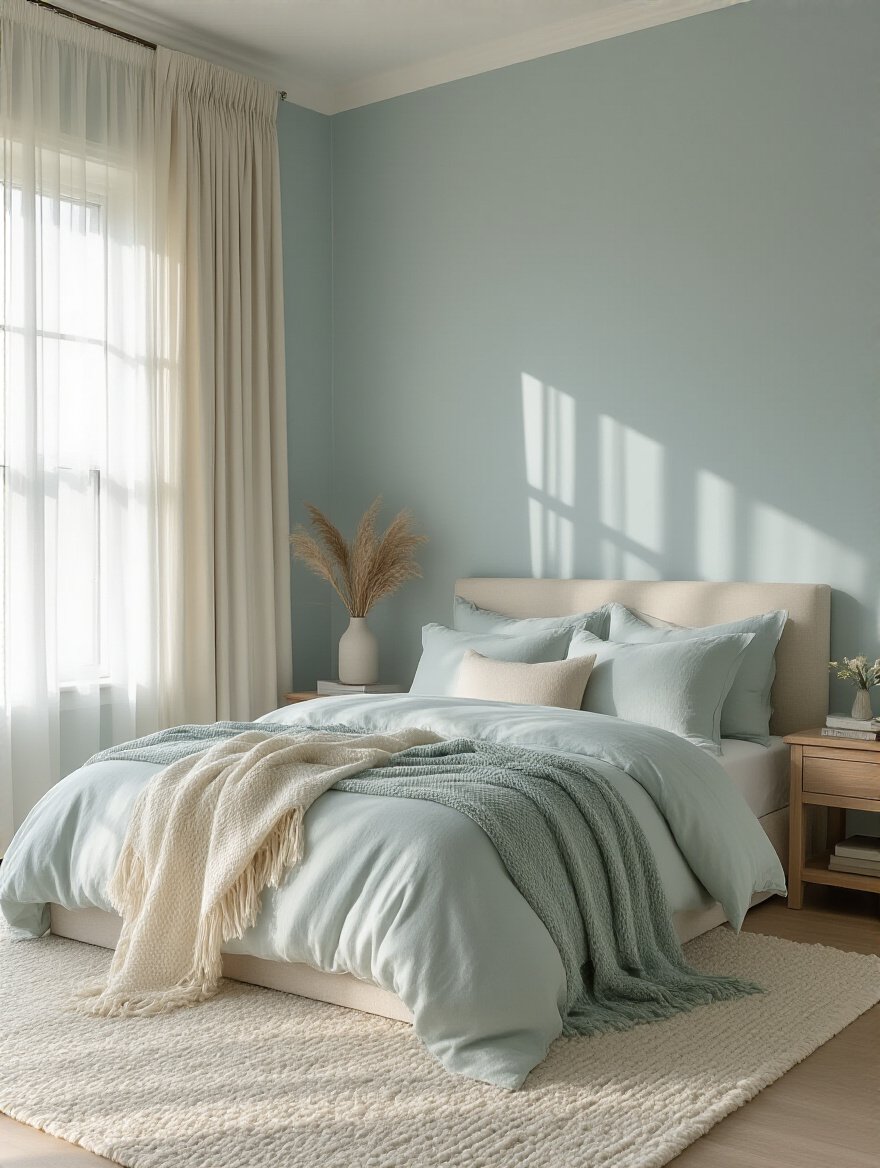
Instead of just picking a color, think in terms of a palette. A good rule of thumb is the 60-30-10 rule. 60% of your room is your dominant color (walls), 30% is a secondary color (bedding, curtains), and 10% is your accent (a throw pillow, a piece of art, a lamp). This creates balance and depth. And please, test your paint. Paint a large swatch on at least two different walls and see how it looks in the morning light, at midday, and at night with your lamps on. The color in the can is never the color it will be in your uniquely lit room.
Color sets the stage, but light is what brings the performance to life, shaping and sculpting the space.
A single, overhead light is the enemy of good atmosphere. It’s harsh, it flattens everything, and it gives you zero control. A well-lit room needs layers, just like a good mix. You need at least three types of light: Ambient, Task, and Accent. Ambient is your general, overall light, like a gentle pad in a track. This could be recessed lights on a dimmer or a central fixture. Task is for specific activities: a focused lamp for reading music, a clear light by the mirror for getting ready. Accent is the drama: a light pointing at a piece of art or up a textured wall, creating depth and shadow.
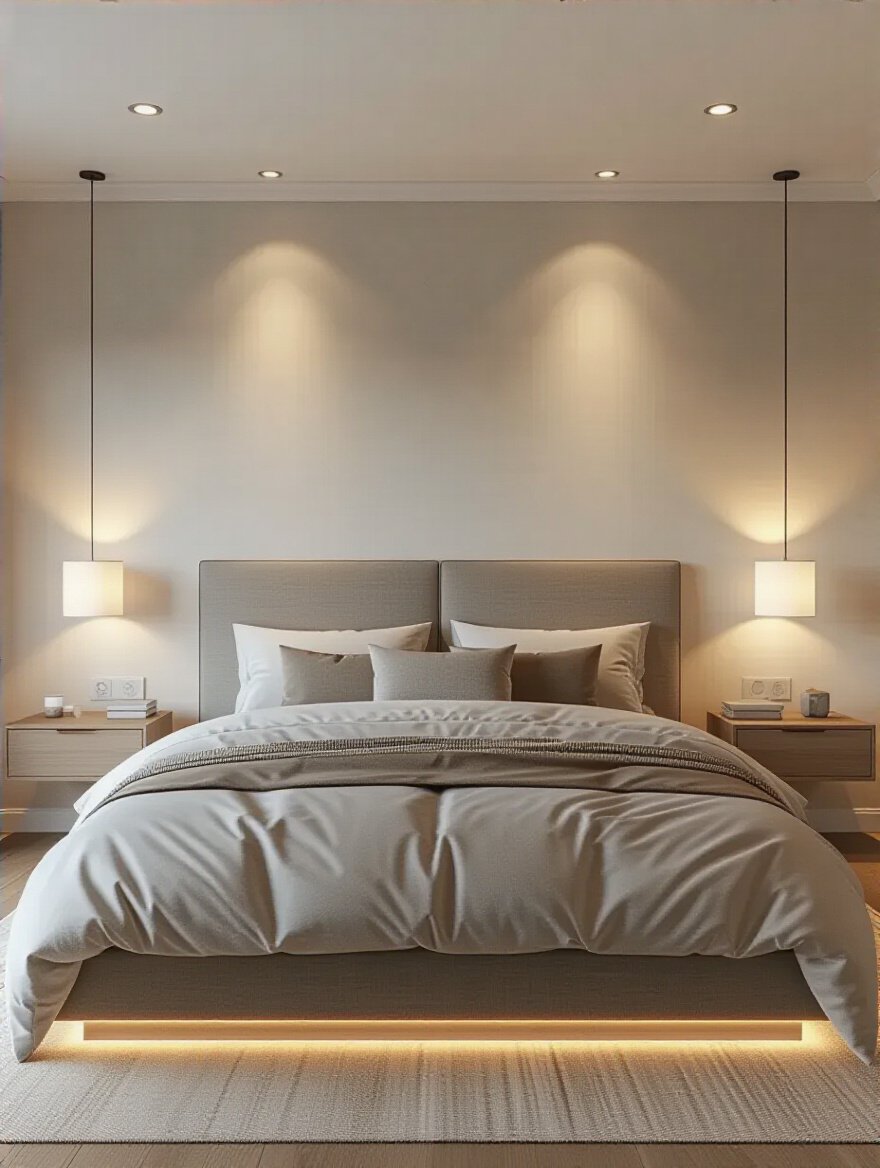
Every single light source in your bedroom should be on a dimmer. This is non-negotiable. The ability to dial down the intensity is the single most powerful tool you have for controlling mood. Smart bulbs and systems are great for this, allowing you to create presets. Imagine a “Practice” scene that brightens your task lamp, or a “Wind Down” scene that shifts all the lights to a warm, amber hue below 2700K, which helps signal to your brain it’s time to produce melatonin for sleep.
As your lighting sets the mood, the things you touch—especially your bedding—provide the tactile comfort that grounds the experience.
Your bed is the one place in the world where you spend a third of your life. Don’t cheap out on the things that touch your skin. And “luxurious” doesn’t mean a 1000-thread-count sheet set. That’s mostly a marketing gimmick. What really matters is the quality of the fiber and the weave. For a crisp, cool, hotel-sheet feel, you want percale. For a silky, smooth, slightly warmer feel, you want sateen. For breathability and a beautiful, relaxed texture, you can’t beat linen.
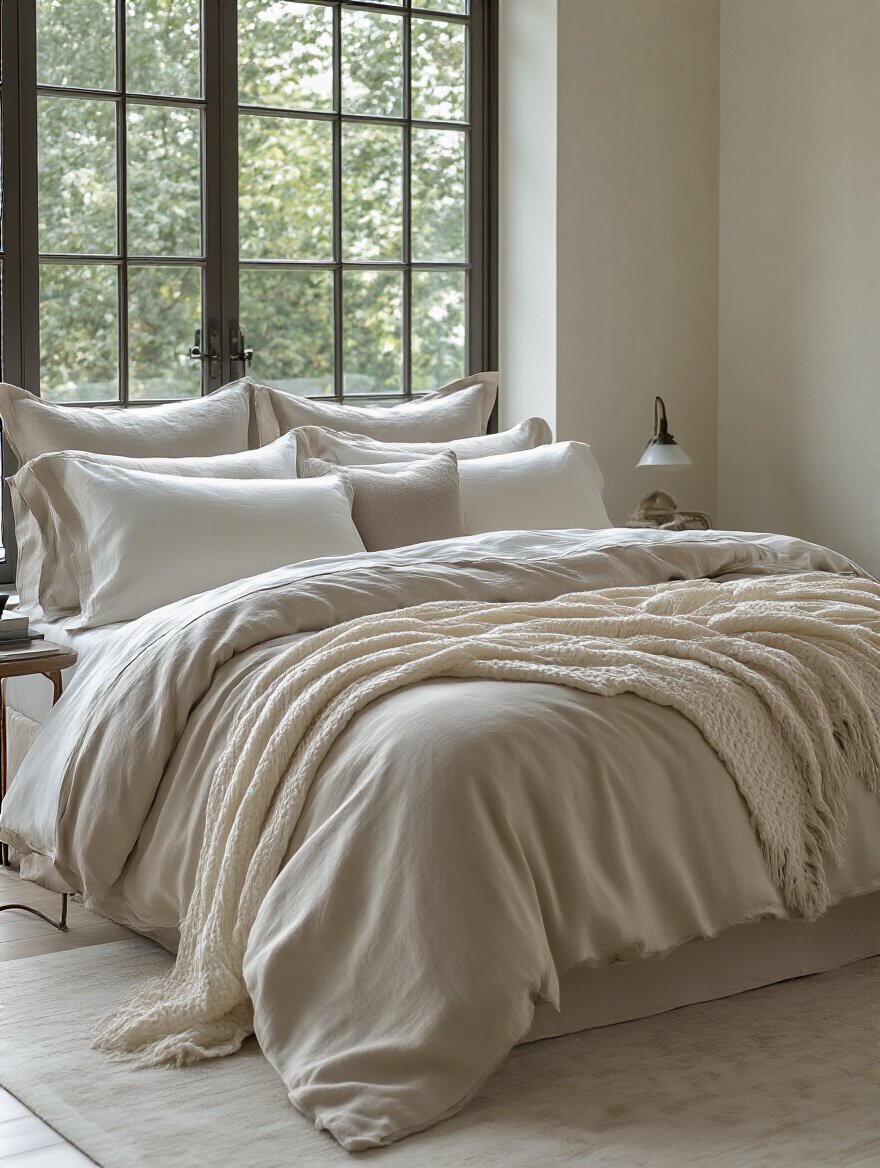
Go to a store and touch them. Feel the difference. Then, layer those textures. A smooth sateen sheet, a nubby linen duvet cover, a chunky knit throw, a velvet pillow. The combination of different textures is what creates a rich, sensory experience. It makes the bed an invitation. I tell my audiophile clients it’s like the difference between a compressed MP3 and an uncompressed WAV file. One is flat; the other is full of depth and detail you can feel.
From the textures you touch, we move to the elements that connect your indoor sanctuary to the natural world outside.
We are biological creatures. We have an innate need to connect with nature, a concept called biophilia. Bringing natural elements into your bedroom is one of the easiest ways to lower your heart rate and create a sense of calm. The easiest way to do this is with plants. Even if you have a black thumb, a snake plant or a ZZ plant is nearly impossible to kill and they’re great at purifying the air.

Beyond plants, think about materials. A solid wood headboard. A wool rug. A stone-topped nightstand. A linen curtain. These materials have a texture and authenticity that manufactured materials like plastic and polyester can never replicate. They have a subtle, organic imperfection that feels grounding. Even just maximizing the natural light and having a clear view of the sky or a tree from your window can make a massive difference in how a room feels.
Just as a view of nature provides a focal point, a carefully chosen piece of art can command the room’s attention and set its entire tone.
A room without a focal point feels unsettled. Your eye doesn’t know where to land, so it just keeps scanning, which is the opposite of relaxing. Often, the bed is the natural focal point, and the easiest way to enhance it is with a significant piece of art above the headboard. “Significant” doesn’t mean expensive; it means it has scale and presence. A common mistake is hanging a piece that’s too small, which just looks lost and lonely. A good rule of thumb is that the art should be about two-thirds the width of your headboard.

The art itself should be something that gives you the feeling you want to have in the room. For some, that’s a calming, abstract landscape. For others, it might be a dynamic, energetic piece that inspires creativity. I had a rock guitarist client who framed and hung a collection of vintage concert posters in a grid above his bed. It was personal, visually striking, and set the perfect vibe for him. And remember to light it! A simple picture light can turn a nice poster into a museum-worthy statement.
Art provides the big statement, but the smaller, carefully chosen decorative objects are what infuse your space with your unique story.
This is about curating, not decorating. Your bedroom should not look like a catalog. It should look like you. This is the place for the objects that tell your story. The small sculpture you bought on a memorable trip. A stack of books that changed your life. An old, inherited clock. A photo that makes you happy every time you see it. These objects hold energy and memory.

The secret is to group them thoughtfully into what designers call vignettes. Create a small, curated cluster on your dresser or nightstand. Use the “rule of three”—grouping objects in odd numbers is almost always more visually appealing. Vary the heights and textures. A tall, thin lamp; a low, wide bowl; and a small, framed photo. This creates a balanced little composition that tells a tiny story. The key is to resist the urge to fill every surface. Negative space is essential. It gives your treasured objects room to breathe and be appreciated.
With your personal story woven in, the next step is to amplify the room’s energy by harnessing the power of daylight.
Natural light is a mood booster, a productivity enhancer, and a free source of beautiful, full-spectrum illumination. Your primary goal should be to get as much of it into your room as possible. That means no heavy, light-blocking drapes unless you absolutely need them for sleep (and even then, layer them with sheers). Opt for light-filtering blinds or linen curtains that give you privacy while still letting the light pour in.

The other pro trick is to use mirrors. A large mirror placed directly opposite a window will literally double the amount of light in that area. It’s the oldest trick in the book because it works. Lighter paint colors on the walls will also bounce light around the room, making it feel brighter and bigger. Keeping your windows clean and the sills clear sounds stupidly simple, but it makes a tangible difference. It’s like cleaning the lens on a camera—suddenly everything is clearer and brighter.
Mirrors don’t just amplify light; they are a designer’s secret weapon for manipulating our perception of space itself.
Beyond amplifying light, mirrors create an illusion of depth that can make a small room feel significantly larger. Placing a large, floor-length mirror against a wall can make it feel like there’s another room beyond. Putting a wide mirror above a dresser can visually push the wall back. It’s a powerful tool for tricking the eye.

Be careful what your mirror reflects, though. It’s a second window, so point it at something beautiful—a window with a nice view, a great piece of art, or a beautifully styled vignette. You don’t want to double a view of a cluttered corner or the door to the bathroom. My favorite placement for a musician’s room is often in a corner, angled to reflect the instrument they keep in the room. It adds a bit of gallery-like drama and makes the space feel more dynamic.
Now for my favorite part. Once the room is visually tuned, we need to tune it sonically for ultimate peace.
This is my bread and butter. Creating true serenity in a room is about two things: Isolation and Treatment. Isolation is blocking outside noise—the “soundproofing.” Treatment is controlling the sound inside the room. Most people ignore the second part. A room with only hard surfaces (hardwood floors, bare walls, big windows) is a reverberant echo chamber. It’s acoustically harsh and stressful, even if it’s silent.

For isolation, the biggest leaks are your door and windows. A cheap, hollow-core door is basically a sound sieve. Swapping it for a solid-core door is the single biggest upgrade you can make. Seal any gaps around it with acoustic sealant and a good door sweep. For windows, heavy, lined curtains help, but for serious noise, look into sound-insulating laminated glass windows or even secondary interior window inserts. For treatment, you need to add absorption. A thick, plush wool rug is a must. Upholstered furniture. Even a fabric headboard. Purpose-built acoustic panels disguised as art have come a long way and can be a game-changer for absorbing flutter echo between parallel walls.
With your room now a visual and auditory sanctuary, we can add the final layers of smart functionality that make modern living effortless.
This is the encore. You’ve built a beautiful, serene space. Now, let’s make it work for you on a deeper level, anticipating your needs and reflecting your unique identity with clever, modern touches.
Your nightstand is command central for the beginning and end of your day. But it’s also a magnet for clutter—the visual noise we’re trying to eliminate. The solution is storage that is both smart and discreet. Look for nightstands with drawers or doors, not just an open shelf. You want a place to hide the charging cables, the hand cream, and the half-finished paperback.

Floating nightstands are brilliant because they free up floor space and make cleaning easier, creating a less-cluttered look. Another great option is a headboard with built-in storage. I recently designed one for a client with a hidden compartment on top that hinges open, revealing a power strip for all their devices. When it’s closed, you’d never know it was there. The goal is to have everything you need within arm’s reach, but out of sight.
From smart storage, we move to truly smart technology, which can automate the comfort of your room with invisible precision.
The best technology is the kind that feels invisible. It shouldn’t be about gadgets and blinking lights; it should be about creating an environment that responds to you. This is where a simple smart home setup in the bedroom is so powerful. Imagine saying “Goodnight,” and the lights dim slowly, the thermostat adjusts to your ideal sleeping temperature, and a white noise machine fades in. No fumbling for switches, no getting out of bed.

The key is to start small and focus on your sleep routine. Automated blackout blinds that slowly open in the morning to wake you with natural light can be life-changing. Smart bulbs that can shift color temperature from a cool, energizing blue-white in the morning to a warm, sleepy amber-white at night work in sync with your circadian rhythm. Don’t get overwhelmed by the options. Pick one thing that will solve a specific annoyance in your daily routine and build from there.
While tech provides modern comfort, sometimes the greatest luxury is a dedicated, analog space to simply unplug.
In our hyper-connected world, the most luxurious thing you can have is a dedicated space to disconnect. A reading nook is a sanctuary within your sanctuary. It’s a clear signal to your brain—and anyone else in the house—that this is a space for quiet and focus. All you need is a comfortable chair, good light, and a small table.

Find an underused corner, maybe by a window or an empty alcove. Get the most comfortable chair you can find—this is a great place to splurge. Add a dedicated task light, like a floor lamp that arches over your shoulder, so you’re not straining your eyes. Add a small side table for a cup of tea or a stack of books. It’s a simple formula, but having that dedicated spot makes you infinitely more likely to choose reading a book over scrolling through your phone before bed.
This cozy nook is a perfect example of a personalized space, which is the final, most important brushstroke in your design.
This is where you make the room undeniably yours. It’s about displaying things that have a genuine story, not just things that “go with the decor.” Did you write your best song on a particular guitar? Don’t hide it in a case; mount it on the wall as art. Frame a copy of a concert ticket from a life-changing show. Display a piece of pottery you made. It’s these touches that give a room a soul.

Embrace imperfection. That worn leather chair you inherited might have a few scratches, but it also has character and history. A slightly faded vintage rug has more story to tell than a brand-new one from a big box store. Don’t be afraid to mix old and new, high-end and humble. The most interesting spaces are the ones that feel like they were collected over a lifetime, not decorated in a weekend. Your space should be a reflection of your journey.
Your personal touches deserve to be enjoyed in comfort, which means having total control over privacy and light.
Controlling light is about more than just mood; it’s about creating a secure and private sanctuary. You need the ability to block out the world when you want to. Blackout capability is crucial for sleep, as even small amounts of light can disrupt your circadian rhythm. But you also want soft, filtered light during the day. This is where layering Window Treatments is key.

A fantastic combination is to install a blackout roller shade inside the window frame and then hang softer, sheer curtains on a rod outside the frame. This gives you the best of both worlds. The roller shade provides complete darkness when you need it, and the sheers provide privacy and beautifully diffused light during the day. Motorizing the roller shade is a game-changing luxury, allowing you to raise and lower it with the touch of a button from your bed.
Finally, a truly well-designed space is one that is built not just for today, but for all the tomorrows to come.
Life isn’t static. The room you design today might need to serve a different purpose in five or ten years. Designing for versatility means you won’t have to start from scratch. The easiest way to do this is with a neutral foundation. Timeless flooring, classic wall colors, and simple, well-made furniture create a backdrop that can be easily updated with new bedding, art, and accessories as your tastes evolve.

Think about flexible furniture. A desk that can later become a vanity. A beautiful bench that can move from the foot of the bed to a hallway. Most importantly, plan your electrical outlets. You can never have too many. Put them in more places than you think you’ll need. This gives you total freedom to rearrange your furniture in the future without being tethered to an ugly extension cord. A versatile room is a sustainable room, both financially and stylistically.
So, there it is. Your bedroom is so much more than a room with a bed. It’s an acoustic chamber, a light studio, a sensory retreat, and a reflection of your creative spirit. By thinking like a designer and an engineer, you can orchestrate a space that is not just beautiful to look at, but is perfectly tuned to support your rest and creativity. It’s about building harmony between sight and sound, texture and light, function and feeling.
Don’t get overwhelmed by all 21 points. Just pick one. Start with one thing that resonates with you—maybe it’s finally buying that solid-core door, or finding the perfect piece of art, or just putting all your lights on dimmers. Every small, intentional choice is a note in a larger composition. Over time, those notes will build into the sanctuary you deserve. Your ultimate retreat is waiting. It’s time to start the music.